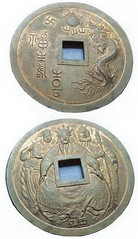
About UsThe Numismatic Bibliomania Society is a non-profit organization promoting numismatic literature. For more information please see our web site at coinbooks.org SubscriptionsThose wishing to become new E-Sylum subscribers (or wishing to Unsubscribe) can go to the following web page link MembershipThere is a membership application available on the web site Membership Application To join, print the application and return it with your check to the address printed on the application. Membership is only $15 to addresses in the U.S., $20 for First Class mail, and $25 elsewhere. For those without web access, write to: David M. Sundman, Secretary/TreasurerNumismatic Bibliomania Society AsylumFor Asylum mailing address changes and other membership questions, contact David at this email address: dsundman@LittletonCoin.com SubmissionsTo submit items for publication in The E-Sylum, just Reply to this message, or write to the Editor at this address: whomren@coinlibrary.com BUY THE BOOK BEFORE THE COINYou won't regret it! |
- WAYNE'S WORDS: THE E-SYLUM OCTOBER 3, 2010
- LAKE BOOKS SALE #104 PRICES REALIZED AVAILABLE
- SKLOW NUMISMATIC LITERATURE SALE 11 CLOSES OCTOBER 9, 2010
- NEW BOOK: RARE COIN INVESTING BY DAVID GANZ
- BOOK REVIEW: MODERN FEDERAL RESERVE NOTES, 1963-2009
- BOOK REVIEW: MONOGRAMS OF AMERICAN COIN AND MEDAL ARTISTS
- PIERRE DU SIMITIÈRE'S PORTRAITS, 1783
- HARVEY STACK: HOW NEW YORK BECAME THE COIN CAPITAL
- THE COIN &MEDAL BULLETIN
- ON THE REDBOOK PUBLICATION SCHEDULE
- TO PRICE OR NOT TO PRICE? HERE ARE SOME ANSWERS
- QUERY: IS MYSTERY TOKEN A THOMAS ELDER PRODUCT?
- QUERY: AN ODD 1943 COPPER CENT
- MORE ON COINS AND MEDALS EMBEDDED IN LUCITE
- STANLEY APFELBAUM, FIRST COINVESTORS AND ADELPHI
- MORE ON THE MYSTERY OF B. MAX MEHL'S COST CODE
- NOTES FROM E-SYLUM READERS: OCTOBER 3, 2010
- NUMISMATIC WINE AND CIGARS
- ANOTHER BANKNOTE PAPER PROBLEM: BEP DELAYS NEW $100 BILL
- SWEDEN PAYS ITS LAST RESPECTS TO THE ÖRE
- ARTICLE HIGHLIGHTS NAZI OPERATION BERNHARD COUNTERFEIT BANKNOTE
- THE MAINE PENNY: A MEDIEVAL COIN FOUND IN NEW ENGLAND SOIL
- A DESKTOP STUDDED WITH CENTS
- A BATHROOM FLOOR TILED IN NICKELS
- FEATURED WEB PAGE: AUSTRALIAN MONETARY HISTORY
WAYNE'S WORDS: THE E-SYLUM OCTOBER 3, 2010

Among our new subscribers this week is Bruce Roland Hagen of Stack's. Welcome aboard! We now have 1,370 subscribers.
This week we open with numismatic literature sale updates from Fred Lake and David Sklow, an announcement of a new book by David Ganz and two book reviews.
Other topics include New York coin dealers, the Coin and Medal Bulletin, some mystery coins, and coins and medals embedded in Lucite. To learn about reverse ciphers, the Founding Father of American Numismatics, Stanley Apfelbaum and the Maine Penny, read on. Have a great week, everyone!
Wayne Homren
Numismatic Bibliomania Society
LAKE BOOKS SALE #104 PRICES REALIZED AVAILABLE
The prices realized list for our 104th numismatic literature mail-bid sale is now available for viewing on our web site at http://www.lakebooks.com/archive.html . Scroll down to the listing for sale #104 and you will see the two viewing options...either PDF or MS Word format. The sale was active with 445 lots being sold.
Our next sale will be held on November 30, 2010 and will feature selections from the library of Eric von Klinger. The catalog will be available for viewing on our web site toward the end of October.
Many thanks for your continued interest in our offerings.
Lake Books
6822 22nd Ave. N.
St. Petersburg, FL 33710
727-343-8055 Fax 727-345-3750
SKLOW NUMISMATIC LITERATURE SALE 11 CLOSES OCTOBER 9, 2010
PART THREE OF “THE MASTER OF WOLFEBORO”
Q. DAVID BOWERS RESEARCH LIBRARY
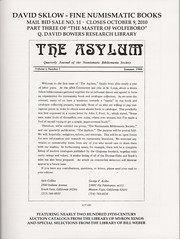 From the
research &source library of Q. David Bowers comes over two-hundred and fifty lots concerning the American Civil War, Maritime history and ships, references on every type of
collectible and the memorabilia of Abe Kosoff.
From the
research &source library of Q. David Bowers comes over two-hundred and fifty lots concerning the American Civil War, Maritime history and ships, references on every type of
collectible and the memorabilia of Abe Kosoff.
The sale also features nearly two-hundred, nineteenth century auction catalogs spanning 1855-1875 from the library of numismatic publisher and literature dealer Myron Xenos and special selections from the library of Bill Weber.
Bidders may enter bids by mail, telephone, email or fax. The sale closes at 8pm mountain time, October 9, 2010, however, any bids left on our answering machine or sent by email or fax on or before midnight will be accepted.
Catalogs are available upon request at no charge or can be found on our website.
DAVID SKLOW – FINE NUMISMATIC BOOKS
P.O. BOX 6321
COLORADO SPRINGS, CO 80934
TEL: (719) 302-5686
FAX: (719) 302-4933
finenumismaticbooks@aol.com
www.finenumismaticbooks.com
We are seeking numismatic literature consignments for future auctions. Please contact us for terms.
NEW BOOK: RARE COIN INVESTING BY DAVID GANZ
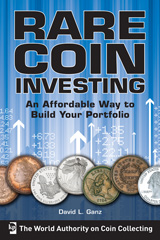 Investors looking to broaden their
retirement portfolios beyond stocks and bonds will learn details of an intriguing market in Rare Coin Investing, a new book from coin and paper money publisher Krause
Publications.
Investors looking to broaden their
retirement portfolios beyond stocks and bonds will learn details of an intriguing market in Rare Coin Investing, a new book from coin and paper money publisher Krause
Publications.
Studies show that the same amount of money invested in the stock market and in rare coins can result in a better return with the rare coins approach. Plus, it doesn't take thousands of dollars or finding the rarest of the rare coins to see a profitable return on an investment. For as little as $100 per coin, investors can start building a portfolio that can bring solid gains, and this book from noted coin expert David L. Ganz can help:
- Learn how great coin collections were built with low-cost coins.
- See how a portfolio of coins gained in value over 10 year, 20 years, 30 years and more.
- Review the author's recommendations for affordable coins available for purchase today.
For more information visit www.shopnumismaster.com/product/rare-coin-investing/us-coins .
Author David L. Ganz is a past president of the American Numismatic Association. A lawyer by profession, he has practiced as senior partner in the New York firm of Ganz & Hollinger, P.C. since 1980. His column "Under the Glass" has appeared in Numismatic News for the past 41 years, and he has served as a contributing editor to Coinage Magazine since 1973.
BOOK REVIEW: MODERN FEDERAL RESERVE NOTES, 1963–2009
 Numismatic researcher and
paper-money dealer Robert Azpiazu offers the definitive guide to modern Federal Reserve Notes of the $1, $2, $5, $10, $20, $50, and $100 denominations. Drawing on his own
expertise, as well as assistance from a distinguished panel of hobby leaders, Azpiazu presents a detailed and reader-friendly study and checklist for FRN collectors.
Numismatic researcher and
paper-money dealer Robert Azpiazu offers the definitive guide to modern Federal Reserve Notes of the $1, $2, $5, $10, $20, $50, and $100 denominations. Drawing on his own
expertise, as well as assistance from a distinguished panel of hobby leaders, Azpiazu presents a detailed and reader-friendly study and checklist for FRN collectors.
Whether you're an experienced collector or completely new to this popular segment of the U.S. paper-money market, the Collector's Guide to Modern Federal Reserve Notes gives you the guidance and tools to build an advanced collection-with many notes to be found in circulation, at face value!
Contents include:
- How to collect by denomination, date series, and Federal Reserve District
- Full coverage of star replacement notes
- Detailed listings of low and high serial numbers for each block, at each facility, for $1 through $100
- Market values in Choice Crisp Uncirculated condition
- Series Summaries with commentary on scarce notes, and other valuable tips
The Collector's Guide will debut in November 2010.
To read the complete article, see: NEW BOOK: MODERN FEDERAL RESERVE NOTES, 1963–2009 (www.coinbooks.org/esylum_v13n23a06.html)
BOOK REVIEW: MONOGRAMS OF AMERICAN COIN AND MEDAL ARTISTS
 This
week my copy of Dick Johnson's new book arrived. Monograms of American Coin and Medal Artists is exactly what Dick promised: a compendium of 545 drawings of signatures
of nearly 300 coin and medal artists, painstakingly compiled over four decades of research.
This
week my copy of Dick Johnson's new book arrived. Monograms of American Coin and Medal Artists is exactly what Dick promised: a compendium of 545 drawings of signatures
of nearly 300 coin and medal artists, painstakingly compiled over four decades of research.
Need I say more? Such a wealth of information is available no where else, and is a dirt-cheap bargain for the numismatic researcher regardless of the cover price (only $45 postpaid from the publisher, Signature Art Medals, P.O. Box 920, Groton, MA 01450).
Each artist entry includes one or more monograms, and for each monogram there is a list of known medals displaying that version of the monogram. A typical example is the entry for Ernest Bruce Haswell. Shown are two different monograms - one an H within a circle (found on the 1916 Edward MacDowell medal) and "E B H", found on the 1936 Miami University Robert Hamilton Bishop medal.
Below are examples of three different monograms of Victor David Brenner.

While many artists had just one standard monogram, some used many different ones over the years. Johnson illustrates 14 different monograms for John Flanagan, with a two-page listing of coins and medals they appeared on. What a wealth of information!
At the risk of sounding like a carnival tout or infomercial salesman, wait! There's more! The 29 pages of front matter are invaluable, starting with a four-page listing of "Monogram &Signature Terms You Should Know", including Ad Vivum, Ghosting, Impresa and Reverse Cipher. QUICK QUIZ: without referring to Dick's book, who can define more than one of these?
The 20-page introduction is a very readable and accessible overview of how to read and understand monograms and signatures on coins and medals - practically a graduate course in forensic numismatics.
Identifying the signature on a numismatic item is often the most time-consuming and irksome task of the numismatist, cataloguer, or curator. Determining the identity of these tiny letters or symbols is sometimes difficult to discern because of wear, their hidden location, the obscurity of their creator or just the vicissitudes of time in lost knowledge or ignorance.
Yet, no other datum can be as important as the identity of the artist or creator of the piece at hand. "Who made it?" is often as important as "what is it?" (p9)
Johnson rightly laments that not all numismatic works are signed, and estimates that perhaps only 20-30% of all American coins and medals are signed. As a result, the identity of the creators of many of these pieces may forever be unknown.
Johnson also notes that
Numismatic literature is full of monogram misattributions. After all. It is difficult to be absolutely certain of attributing a numismatic item to the correct artist by observation of only a few tiny letters. (p18)
Lastly, the introduction includes a great bibliography of monogram reference works, only some of which are typically found in numismatic circles. In summary, Monograms of American Coin and Medal Artists is an extremely useful work that deserves a home in every important numismatic library. How did we get by without it for so long?
To read the earlier E-Sylum article, see: NEW BOOK: MONOGRAMS OF AMERICAN COIN AND MEDAL ARTISTS (www.coinbooks.org/esylum_v13n32a04.html)
THE BOOK BAZARRE
PIERRE DU SIMITIÈRE'S PORTRAITS, 1783

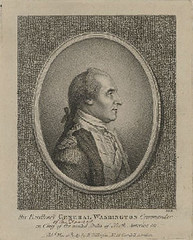
LOT 584
DU SIMITIÈRE, PIERRE EUGÈNE Portraits of the Generals, Ministers, Magistrates, Members of Congress, and Others, Who have rendered themselves Illustrious in the Revolution of the United States of North America. London: R. Wilkinson &J. Debrett, 1783
4to (9 1/4 x 6 7/8 in.; 235 x 175 mm). Letterpress title, advertisement, 12 portrait plates signed "B.B.E." after Du Simitière, Drayton portrait with paper overslip correcting caption, caption to Washington portrait corrected in manuscript; lightly browned, title edgestained, faint dampstain in outer margin, tiny oval library stamp on verso of each plate, plates numbered in ink at upper left corner. Modern half-calf and marbled boards, gilt-stamped title label on spine.
ESTIMATE 4,000 - 6,000 USD To read the complete lot description, see: Sotheby's Copley Library Sale 15 October 2010 Lot 584
Our resident Du Simitiere expert Joel Orosz has this to add. Thanks!
Sotheby's is correct in speculating that General Washington sat for Pierre Eugene Du Simitiere during the Winter of 1778-1779--the precise date was February 1, 1779, John Jay, then President of Congress, accompanied Washington to Du Simitiere's home at Arch above Fourth Street (the site of the current United States Mint!), where the general sat for the artist for about 45 minutes.
The Washington drawing was part of a series of 15 Revolutionary-era worthies, but when the engravings were first published in Paris, only 13 were actually executed by the celebrated engraver Benoit Louis Prevost. A number were captured at sea by the British, others were damaged in transit, and it was not until 1782 that fragmentary sets reached America.
Then in 1783, two different English pirated editions came out with five days of each other--of which this copy being offered by Sotheby's is one. Du Simitiere, who had been counting on sales of these engravings to better his dismal financial condition, received no royalties from the pirated editions, and this was one of the factors (along with the amputation of a joint from a finger on his left hand), which led to his death, possibly by starvation, in October of 1784.
When his historical collections were sold at auction on March 19, 1785, the aggregations of coins and paper money contained within made this the earliest known public auction of a numismatic collection in the United States. Those interested in learning more about Du Simitiere's numismatic exploits are directed to my long out-of-print book, The Eagle That is Forgotten: Pierre Eugene Du Simitiere, Founding Father of American Numismatics. Numismatic booksellers often have copies in stock.
As readers know, Joel and Len Augsburger are working on a new book about Frank Stewart and the first Philadelphia Mint. Joel was in Philadelphia this weekend for the Whitman coin show. He adds:
It dried out enough here today for Len and me to hold our first Mint-related sites walking tour and exhibition of Stewart coins at the West Wing of Independence Hall. A good time was had by all. Whitman also did more than a dozen photopanels of photographs and text from the book and put them up by the entrance to the bourse. Cool stuff. The plan is to have the Stewart book ready for sale at the FUN show in Tampa in early January.
THE BOOK BAZARRE
HARVEY STACK: HOW NEW YORK BECAME THE COIN CAPITAL
I asked Harvey Stack for his thoughts on the history of cooperation among coin dealers in New York. Here's his essay on "How New York Became the Coin Capital of the World". -Editor
When one reviews history of the growth of numismatics in America, it can be found that Coin Collecting, the hobby, started to grow in size in the Northeast States, from Maine to Virginia, after the Civil War was over.
Some great collections were developed by the famous Adams Family, the Garrett family and other great collectors. Though they each had a profound interest in Colonial and early American Coins, their proximity to the Mint in Philadelphia gave them a great source to develop their collections.
The main cities that had some collectors and some dealers to service them were New York, Boston, Philadelphia and Baltimore. Dealerships started and grew with the issuance of price lists and some occasional auction sales. Some important clubs and societies were established, which attracted collectors to their meetings. However growth, by the time of the Depression period in the 1930's growth of the hobby slowed to a snail pace.
With the advance of the price of gold from $20.67 to $35.00 in 1933, a small industry started to grow. Gold coins received greater recognition and people sold them as well as other gold items they possessed just to get by. There was always someone there to convert the items to cash.
It was in this environment that the Stack Family went strictly into the coin business and left their other forms of business aside, which included Postage Stamps, antiques and anything else that they could buy and sell. After all, during the depression there usually weren't extra funds to help other collecting fields stay alive.
There seemed to be a concentration of dealers in the New York area. After all, the city was known for its jewelry trade and it was much easier for them to go to the coins, which mostly were of precious metal, than some other field.
Some dealers were already in the field. Wayte Raymond, F.C.C BOYD, McAllister, John Zug, Tom Elder, Barney Bluestone, Henry Chapman, David Proskey, to mention but a few, together with the great promoter and super advertiser of the time, B. Max Mehl of Ft. Worth Texas.
However, as many of the known collectors of the period lived and worked in New York, it was easy to see how the dealerships grew. New York offered a good group of dealers, the most important American Numismatic Society, the New York Numismatic Club, as well as the Bronx and Brooklyn Clubs, the developing Chase Money Museum, plus a number of the other museums who had coins as part of their displays. These all attracted collectors to the City and it became a "hub" for numismatics.
The Stack Family developed a different type of showcase for their coins. They introduced sit-down counters, a group of experts to guide collectors and a numismatic library that collectors could use for learning more about their collections.
It was this atmosphere which attracted both small and large collectors to the first Stack offices at 690 Sixth Avenue. This was near 23rd Street where commerce was growing quickly. Within a short period other dealers opened their offices in the vicinity of the Stack shop. But most did not have a walk-in shop from the street with a warm sit-down enviorment for collectors to review coins, but rather upstairs offices which were generally small and not always inviting.
By 1942, with the subway being built on 6th Avenue, the Stack family moved its location to West 46th Street, and within the next decade created a new center for collectors. The shop and offices became a club house for coin collectors whenever they visited New York.
By the time Stack's moved to West 57th Street in 1953, they had about them a circle of dealers, which included such names as Wayte Raymond, New Netherlands Coin Co., with Charles Wormser at the Helm (he was Moritz Wormser's son), Hans M.F. Schulman, Royal Athena Galleries, Max Kaplan, Tom Wass, and sometime later Lester Merkin. Also, before moving to California Abe Kosoff and Abner Kreisberg opened Numismatic Galleries near by. These dealers surrounded the area of the Stack location, all hoping to share in the attraction that the Stack offices provided.
In addition, by 1953, the City boasted having at least a dozen active coin clubs, whose members were the 'Who's Who' of the time, and whose collections were bought and sold in New York. The numismatic clubs of New York grew to such importance nation- wide that they, jointly, created the New York Numismatic Convention, which was held annually for well over a decade.
Many of the auctioneers who sold collections for clients used New York as its place to sell. It was located in an area where many collectors lived, and was easily reached from Boston, Hartford, the five New York Boroughs, the affluent Westchester County, all points of Connecticut, New Jersey, as well as Philadelphia, Washington D.C., Baltimore and all the other main collecting cities.
During the Stack Family tenure in New York, they alone had over 800 public Auctions and attracted hundreds if not thousands of collectors to the City. Many other companies added to that figure, and more Public Coin Auctions were conducted in New York than any other city in the world.
It is obvious from the above why out-of-town dealerships tried to establish themselves in the "Big City". It was a natural center of numismatics. Just recently the well known firm of Heritage opened a shop just a few blocks away from the "Stack Club House" with the expectation of growing within the city.
Just for the record, they are not the First Texans to try to grow in New York. In the 1930's B. Max Mehl of Texas, came to New York to partner with Wayte Raymond, but found he couldn't make it in New York and returned to Ft. Worth to continue his most exciting coin dealership. He conducted Mail Bid Auctions from Ft. Worth and sadly never returned to New York.
It is with sincere hope that Heritage Galleries can succeed.
Now you know why NEW YORK is the "Coin Capitol of the World" !
Harvey adds:
The dealers I mentioned in my essay usually helped each other out by not running a conflicting sale on the same day, supporting the others' sales by bidding for clients, sharing deals they couldn't handle themselves and joining into the fun in the Stack showroom when they had some time to relax.
A perfect example of cooperation was Hans M.F. Schulman, who got King Farouk as a personal account and sold to him many of the special coins the Stack family assembled. Conversely, when we had the job of building the J.K.Lilly collection from 1951-1967, Hans, while traveling the world, would help us locate and acquire many of the foreign gold coins for the collection, which is now housed in the Smithsonian.
To read the earlier E-Sylum article, see: NUMISMATIC GOSSIP: MANLEY HOME, NEW YORK SHOWDOWN (www.coinbooks.org/esylum_v13n39a21.html)
THE BOOK BAZARRE
NOVEMBER 18, 2010 AUCTION SALEA Diverse Selection of Interesting and Elusive Works on Ancient,
Medieval and Modern Numismatics
Particularly Rich in Numismata Americana
Catalogue Available at Our Web Site: www.numislit.com
Printed Catalogues $10.00
KOLBE &FANNING NUMISMATIC BOOKSELLERS
141 W JOHNSTOWN ROAD, GAHANNA OH 43230-2700
(614) 414-0855 • df@numislit.com • GFK@numislit.com
THE COIN &MEDAL BULLETIN
John Adams' article in the recent issue of THE ASYLUM (v. 28, nos. 2) regarding the Raymond-Adams publication titled Coin &Medal Bulletin is yet another example of Mr. Adams' fine writing style and insights. In addition to the auction listings cited in the article for complete sets of the Raymond-Adams Coin &Medal Bulletin, Charlie Davis' American Numismatic Literature (1992) lists two auction sales for complete sets as Wilson 8-1983 and Kolbe 10-1991.

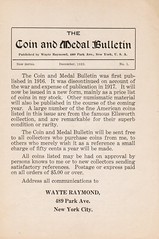
While Mr. Adams rightfully points out the emission of eleven issues, to clarify, the publication was actually issued as numbers vol. I: 1-3, 4/5 double issue, 6-9, 1916; and vol. II: 1-3, 1917 yielding "12 numbers in 11." I have attached an image of a subscriber's card for the Coin &Medal Bulletin (first series). My own set was secured in the Katen Library Sale, 3-1995.
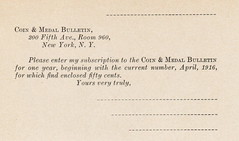
Equally elusive to the set of the Coin &Medal Bulletin, 1916-1917 in my library is a set of the Coin &Medal Bulletin "New Series" published in 17 issues from December, 1923 until the final issue January 1933; a span of slightly more than 10-years. Attached are images from initial issues of both the "Original" and "New Series." My personal set was secured privately 7-1993. I will submit an article for a subsequent issue of THE ASYLUM on the "New Series" to which Mr. Adams may wish to contribute.
ON THE REDBOOK PUBLICATION SCHEDULE
Gary Dunaier writes:
I came across a blog, "Coined For Money," which reviews the 2011 Red Book in the form of short "soundbite" comments. Most interesting thing the guy says comes at the end, as part of his recommendations on whether or not the '11 Red Book is a worthy purchase: "If you do not own one wait until the 2012 because rumor is it will be out by February."
Is there any truth to this rumor?
Well, I went straight to the source and asked Dennis Tucker of Whitman Publishing, who writes:
Keen-eyed observations from this blogger. It's good to know that somebody actually reads the book's front matter --- right down to the abbreviation charts!
In recent years we've been debuting the Red Book at the ANA's National Money Show. The 2012 edition will roll out in Sacramento, March 17, 2011.
To read the complete blog, see: 2011 Red Book (coinedformoney.blogspot.com/2010/09/2011-red-book.html)
TO PRICE OR NOT TO PRICE? HERE ARE SOME ANSWERS
James Higby writes:
A reference book that gives an estimate of rarity alone is not so useful to even a somewhat advanced collector, as it gives no direct indication of value. Demand has to come into the picture somewhere, and demand is going to be expressed in terms of the money it will take to own an example of the coin in question, even if that money is in the form of an estimate and/or quickly goes out-of-date. Knowledgeable collectors should be able to handle ball-park figures, while less experienced collectors require them to get their bearings.
There are Civil War store cards of which there are only one or two examples known, but they will bring nowhere near the money that a draped bust, small eagle half dollar will bring, even with around 200 known. That's called demand.
Fred Schwan of BNR Press writes:
Ken Bressett taught me that the dollar amounts listed in books are best called values rather than prices. Prices are for items that are actually for sale.
You do not need values in numismatic books unless you want them to sell. The unfortunate truth is that for a book to sell, it needs to have values. True, there are a few exceptions, Coins and Collectors (my favorite) is one example. There are positives to this truth. Even if David Lange is correct that values are often little more than guesses, they are still the guess of an apparent expert and can be of use to readers.
I have told this story many times. I was releasing a book at a European show. At a reception before the event, I was discussing the new book with two prominent dealers. One of them was having the first look at the book. Dealer two asked dealer one to look up the value of an item in the brand new book. Dealer one reported the value and dealer two laughed. Uneasily, dealer one asked the value was high or low.
To read the earlier E-Sylum article, see: TO PRICE OR NOT TO PRICE? THAT IS THE QUESTION (www.coinbooks.org/esylum_v13n39a18.html)
QUERY: IS MYSTERY TOKEN A THOMAS ELDER PRODUCT?
The seller stated it was made for Elder in 1911. I have a copy of DeLoreys' Elder Tokens &Medals that he wrote for the ANA back in 1980. This token is not listed.
Tom DeLorey writes:
I do not recall ever seeing anything that would suggest that Elder had this piece made. If he did, he was silent about it in his auction catalogues, which were the basis of my research.
QUERY: AN ODD 1943 COPPER CENT
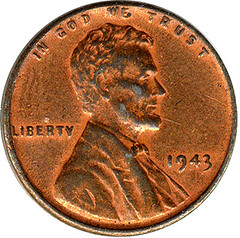
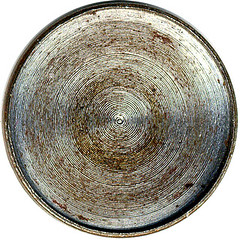
USA, One Cent 1943
Steel
Buste of Lincoln
Wheat ears
KM 132
Milled back
Quality: VF+
Start price: € 20.00
To view the complete lot description, see: USA, One Cent 1943 (collectplaza-auctions.com/auction/?product=15729)
MORE ON COINS AND MEDALS EMBEDDED IN LUCITE
E-Sylum reader Nicholas Graver asked me recently what to do with a group of medals embedded in Lucite. He wanted to know if I know anyone who collected these. In a word, NO, I don't.
Embedding medals in Lucite is one of many ways a medal can be mounted. It's ideal because the medal is easily displayed. It does not damage the medal in any way. It can stand alone, be laid flat or become a paperweight. Lucite has some amazing properties. It is crystal clear, it can embed most any shaped object, it can be molded in many forms, yet after it cures it can be machined, cut, and drilled with hand tools. Also, it can be polished if the surface becomes foggy, scratched, dented or otherwise marred.
Yet, it does not appeal to medal collectors who like to handle the medal, to weigh it, measure it, photograph it or whatever a collector is wont to do. But to form a collection of medals entombed in Lucite is somewhat anathema to numismatics.
I do know of collectors of other forms of medal mounting. Cases appeal to collectors. I know of one California dentist who only collects medals in cases. He displays these in his office for his clients to view. Does that soothe the mouth pain?
The subject of how to remove a coin or medal from Lucite came up before in E-Sylum (vol 9, no 3, art 21). It set off a string of comments. I replied with what I remembered from a letter I had received years before from the best authority I could find, a spokesman from DuPont itself, makers of Lucite.
I didn't remember the correct name of the chemical he had mentioned to dissolve away any remaining particles of Lucite after chipping away gross amounts of Lucite. The wrath of E-Sylum readers came down on me the following week (vol 9, no 4, art 22). I had mentioned "warm galactic acetic acid." When I should have said GLACIAL (not galactic) ACETIC ACID.
Among those who responded were: Roger Burdette, Peter Gaspar (E-Sylum subscriber #1 and professor of chemistry at Washington University), Benjamin Weiss Ph.D (Emeritus Professor of Pharmacology and Physiology at Drexel University College of Medicine), Mike Ellis (guru on minting technology and coining errors), Marc McDonald, and Alan V. Weinberg (who freezes the embedments overnight then whacks them with a sledge hammer in his garage the next day). [But don't try his method without reading his total procedure - you have to protect eyes from flying shards.]
But that's not the end of the story. Two years later Robert Neale responded to someone who suggested fingernail polish remover (vol 11, no 25, art 16).
I am constantly amazed at the collective knowledge of E-Sylum readers. You guys know everything. I am humble in your presence.
Nick Graver adds:
I fear I will still be looking for the best home for these pieces. It is only a small group that I have thrown in a drawer. Not even worth your time as far as the number go.
But is there, somewhere, a Lucite (imbedded) Medal Collector specialist?. We tend to think that there must be a collector of everything if one searches extensively. Is the 'good home' going to be various collectors who are interested in the theme of each medal? You feel there is not a class of collector seeking imbedded medals, regardless of topic. I have a friend who does eBay selling, perhaps he will try offering them.
To read the earlier E-Sylum articles, see: EXTRACTING COINS EMBEDDED IN LUCITE
(www.coinbooks.org/esylum_v09n04a22.html)
MORE ON REMOVING COINS AND MEDALS FROM LUCITE (www.coinbooks.org/esylum_v11n25a16.html)
THE BOOK BAZARRE
NOVEMBER 18, 2010 AUCTION HIGHLIGHTSThe Wayne Homren Collection of Early Newspapers
With Numismatic Articles
Including: a 1787 Description of Fugio Coppers; Birmingham Coppers in 1752;
a 1788 Account of the Massachusetts Mint; Washington, in 1792, on the Mint;
A Contemporary Account of 1794 Dollars; Early Mint Reports; a Contemporary
Account of the 1851 Lewis Roper Sale; and the 1857 Loss of the S.S. Central America.
KOLBE &FANNING NUMISMATIC BOOKSELLERS
141 W JOHNSTOWN ROAD, GAHANNA OH 43230-2700
(614) 414-0855 • df@numislit.com • GFK@numislit.com
STANLEY APFELBAUM, FIRST COINVESTORS AND ADELPHI
Regarding the numismatic program at Adelphi University, Alan Weinberg writes:
I believe it was started by Stanley Apfelbaum, not Applebaum.
David L. Ganz writes:
FCI was First Coinvestors, except when the ANA allowed them again to advertise in The Numismatist after a ban - their first ad read "First Convestors".
And it was Rockville Centre not "Center". I grew up in that town.
Pete Smith's book picks up the story "Founder and President of First Coinvestors. In 1969 it was the first coin company to offer stock on the New York Stock Exchange. Associated with Pine Tree. He was expelled from the ANA in 1972 and reinstated in 1974. He proposed establishment of an independent grading board in 1973. He was appointed to the American Numismatic Association Grading Board in April 1975. In 1978 he founded the Institute of Numismatic and Philatelic Studies at Adelphi University. He served as the Executive Director of the institute. He formed a new company, American Coin and Stamp Ventures Inc"
I lectured at Adelphi; there are tapes of many of them (packaged and sold). I s4till have a set in my library
To read the earlier E-Sylum article, see: MORE ON UNIVERSITY DEGREES IN NUMISMATICS (www.coinbooks.org/esylum_v13n39a23.html)
MORE ON THE MYSTERY OF B. MAX MEHL'S COST CODE
Last week Ron Guth posed a brain-teaser regarding coin dealer B. Max Mehl's cost code. Greg Myer writes:
Max was Jewish and like many of the faith who went into their own business they did their inventory cost by applying the principle from Hebrew that each letter represented a number to English. And typically the ordering of the letters to the numbers spelled out a phrase. So for Max' case, It would be something like: YOUDESPATC i.e. 'You despatc' with the 'h' of despatch missing..... Yeah, it is a reach... usually the sayings are complete. I wrote an article on them for the Texas Jewish Historical Society a few years back.
To read the earlier E-Sylum article, see: THE MYSTERY OF B. MAX MEHL'S COST CODE (www.coinbooks.org/esylum_v13n39a19.html)
NOTES FROM E-SYLUM READERS: OCTOBER 3, 2010
Last week I published an image and lot description from the Anthony Terranova collection of counterstamps:
 Medium golden gray
with steel highlights. BOB DALTON / OUTLAW / KILLED AT COFFEYVILLE / KAN. / OCT. 5. / '95 on six lines at obverse center.
Medium golden gray
with steel highlights. BOB DALTON / OUTLAW / KILLED AT COFFEYVILLE / KAN. / OCT. 5. / '95 on six lines at obverse center.
Sharp-eyed reader Joe Boling writes:
But the engraving doesn't say "Coffeyville." The engraver left a letter out.
Ken Berger writes:
The mention of the Strand Bookstore brought back fond memories. I would visit it often when I was an undergrad at Pace University (near City Hall), a graduate student at NYU (at Washington Square Park), and a federal government employee (at #6 WTC &the Federal Bldg.). You would never know what you would find there. I'd get lost for hours in the basement going through the stacks. Thanks for the memories.
NUMISMATIC WINE AND CIGARS
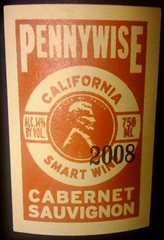 It's non-numismatic, but still fun.
Tom Sheehan forwarded this wine label with a coin theme. He writes: "It's a Napa wine found in Nantucket."
It's non-numismatic, but still fun.
Tom Sheehan forwarded this wine label with a coin theme. He writes: "It's a Napa wine found in Nantucket."
In slightly more numismatic tangent, this week I came across this offering from Pacific Book Auction Galleries: a wooden humidor with medals mounted on top. Click the image to see a full-size version on our Flickr archive. Most are from California events as far back as 1908 and 1915. Is anyone familiar with these medals?

To view the complete lot description, see: Wooden Humidor with California medals mounted to top (www.pbagalleries.com/search/item.php?anr=219456)
THE BOOK BAZARRE
ANOTHER BANKNOTE PAPER PROBLEM: BEP DELAYS NEW $100 BILL
On October 1, the Federal Reserve Board announced a delay in the issue date of the redesigned $100 note. This new design incorporates cutting edge, anti-counterfeiting technologies and the Federal Reserve imposes strict quality controls to ensure that users of U.S. currency around the world receive the highest quality notes. The Bureau of Engraving and Printing manufactures Federal Reserve notes and has identified a problem with sporadic creasing of the paper during printing of the new $100 note, which was not apparent during extensive pre-production testing. As a consequence, the Federal Reserve will not have sufficient inventories to begin distributing the new $100 notes as planned.
The Bureau of Engraving and Printing is working to resolve this problem, and the Federal Reserve Board will announce a new issue date for the redesigned $100 note as soon as possible. The originally scheduled issue date was February 10, 2011. To read the complete article, see: ()
SWEDEN PAYS ITS LAST RESPECTS TO THE ÖRE

The 50 öre coin took its final breath on Thursday and The Local's Peter Vinthagen Simpson has had a look at the life and times of Sweden's last remaining copper coin.
The 50 öre, a little 3.7 gramme copper coin which since 1991 has served as the lowest denomination of the Swedish currency, the krona, was rendered expendable by Sweden's Riksbank in December 2008. On Thursday, September 30th this decision came into effect.
The name öre was derived from the Latin aureus meaning gold but in its dotage the coin was made up of 97 percent copper, 2.5 percent zinc and 0.5 percent tin. It was first introduced as a coin back in 1522 by King Gustav Vasa, then in a silver version, which remained in circulation in various forms until its early demise in 2006.
The decimal system's introduction in Sweden in 1855 gave the öre a renewed vigour, fixing its value as one hundredth of a krona, where it was to remain until its death.
The 50 öre outlived its siblings – the silver 25 öre and 10 öre, and the copper 5 öre, 2 öre, 1 öre and 1/2 öre – who were laid to rest variously in 1873, 1971, 1984 and 1991. It is survived by the one, five and ten krona (silver) coins.
The removal of the öre's silver sibling in 2006 resulted in the disappearance of a total of 125 million kronor ($18.5 million) from the monetary system, and as the death knell sounds for the copper 50-öre coin there is reported to be some 394 million krona remaining in circulation.
Mourners seeking to pay with their last öre at funeral services across the country are encouraged to contact their local store for details.
Furthermore many supermarket chains are cooperating with charities to encourage people to bury their final coins in a coffin of goodwill. The Swedish Red Cross is among those looking at the end of the öre era with optimism, having managed to collect some 344,435 coins to date.
While the öre is no longer with us in person it will live on in print, on the receipts of those making purchases in the post-öre era. Items will still be priced, for example, at 5.50 kronor, and those using charge cards will thus hardly register the loss. With cash purchases the price will be rounded up to a whole krona.
To read the complete article, see: Sweden pays its last respects to the öre (www.thelocal.se/29306/20100930/)
ARTICLE HIGHLIGHTS NAZI OPERATION BERNHARD COUNTERFEIT BANKNOTE
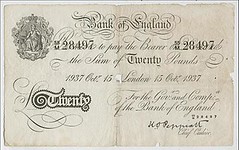 An incredibly rare fake
20 pounds note printed by the Nazis in a scheme to ruin the British economy by flooding the country with fake cash has emerged.
An incredibly rare fake
20 pounds note printed by the Nazis in a scheme to ruin the British economy by flooding the country with fake cash has emerged.
"Operation Bernhard" was launched before the war and the plan was to print money - just like Gordon Brown's quantitative easing method that was designed to save our economy.
The Germans forced Jews in a concentration camp to forge £134 million worth of notes and they had 100 agents ready to put the money into circulation in the UK.
This note - which in the 1940s would have had the buying power of £600 today - has emerged from a private a collector and is now being sold.
It is blank on one side and the other has Britannia at the top and is dated October 1937 and "promises to pay the bearer."
British intelligence got wind of the scheme in 1939 and countered the counterfeiting so successfully that the Bank of England recorded just one as having been paid out.
The Nazis began printing the backdated five, 10, 20 and 50 pound notes in 1942 and created nine million of them valuing 134 million pounds.
Some continued in circulation after the war and resulted in the Bank of England withdrawing all notes with a value of more than five pounds.
And it was not until the 1970s that notes with the denomination of £20 started appearing again.
Ironically for the Germans, the possession of this money became a major factor in identifying Nazi agents and led to many successful arrests.
The note is expected to fetch £400 when it goes under the hammer at Mullock's auction house in Ludlow, Shropshire, on Thursday.
I'm not sure how accurate the article is. The Bernhard notes aren't so rare that they can't be found in the collector marketplace - I own several myself. Is this one a scarce variety? Anyway, it's always interesting to see how numismatic items are portayed in the popular press.
To read the complete article, see: Nazi
fake banknote 'part of plan to ruin British economy' (www.telegraph.co.uk/news/newstopics/world-war-2/
8029844/Nazi-fake-banknote-part-of-plan-to-ruin-British-economy.html)
THE MAINE PENNY: A MEDIEVAL COIN FOUND IN NEW ENGLAND SOIL
 Beachcombing is pleased to introduce a more controversial wrong-place piece, an eleventh-century Viking coin that allegedly ended up in New England's soil several generations before Columbus.
Beachcombing is pleased to introduce a more controversial wrong-place piece, an eleventh-century Viking coin that allegedly ended up in New England's soil several generations before Columbus.
The Maine Penny, as it called, was found by an ‘amateur' (an ugly word for archaeologists) at the Goddard site near the mouth of Penobscot Bay on 18 August 1956. It was identified as an English (sic) silver coin. And it was only in late 1978 that it was correctly identified as a silver Norwegian piece dating to the reign of Olaf the Peaceful (1067–1093).
It is universally accepted that the Goddard site was occupied by Indians in the twelfth and thirteenth centuries and many thousands of items were excavated there. This was an Indian trading hub on the Atlantic Coast.
The discovery of a Viking penny in New England would be remarkable, exciting and worth playing the bagpipes over. But it would not challenge too many historical or archaeological orthodoxies. True no Viking coins have yet been found north or west of Iceland. But there is no question that Vikings settled in Newfoundland in the early eleventh century. And even if this settlement was short-lived, Viking settlements in Greenland continued up until the early fifteenth century. A couple of coins might have found their way over…
There is not even the need to create a ‘Vinland' on Rhode Island or, indeed, a Florida-bound Viking merchant. The coin, could easily have turned up in one of the Viking settlements and then have been traded southwards through Indian intermediaries. Beachcombing should note here that several indigenous objects from the far north arrived at Goddard having followed just that route towards the Equator.
So why the scepticism?
Well, the coin was found by one Guy Mellegren who excavated Goddard and who was, as Beachcombing mentioned above, an ‘amateur'. His notes, for example, were described by a professional as ‘hopelessly sketchy'. (13)
Mellegren had though another far more disgusting secret lurking in his background. He had – the horror! – Swedish ancestry on his father's side… This is not Beachcombing's Vikophobia making itself felt. The problem is that Scandinavian Americans have often been, in misplaced acts of ethnic' pride, behind pre-Columbian Viking ‘finds' in the New World: e.g. the Kensington Stone.
Beachcombing cannot help wondering how many modern New Englanders have some Scandinavian ancestry, but he can also see why a bit of Viking blood might set off alarm bells among archaeologists. And, as with all anomalous finds, the question remains: did Mellegren plant the coin or have it planted on him?
To read the complete article, see: A medieval coin in New England soil
(beachcombing.wordpress.com/2010/09/11/a-medieval-coin-in
-new-england-soil/)
To read the earlier E-Sylum article, see: QUERY: THE MAINE PENNY (www.coinbooks.org/esylum_v12n50a17.html)
A DESKTOP STUDDED WITH CENTS
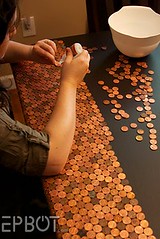
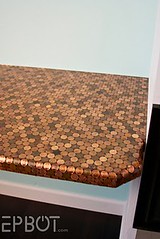
To read the complete article, see: Money Money Money (www.epbot.com/2010/09/money-money-money.html)
A BATHROOM FLOOR TILED IN NICKELS
In March 2010, I came upon the ever-popular Penny Tile floor post on your site. At the time, we were in the process of renovating our 1950s rambler and I was unsuccessful in finding a contractor to complete a concrete overlay (thin-set concrete) design on our master bathroom floor. A standard flooring option just wasn't what we were envisioning for this space…
A floor tiled with pennies was perfect…well, almost. We were building a very modern home in Seattle and the overall color theme was grey and white — copper just didn't seem to integrate well into our design scheme. But nickels did! So, 13,650 nickels later — that's $682.50 — and 30 straight days of gluing the coins to mesh, we have a nickel-tiled master bathroom floor.


To read the complete article, see: Nickel Tile Floor! A DIY Bathroom
Renovation (www.apartmenttherapy.com/sf/how-to/nickel-tile-floor
-a-seattle-bathroom-renovation-127976)
FEATURED WEB PAGE: AUSTRALIAN MONETARY HISTORY
This week's Featured Web Page is suggested by John &Nancy Wilson, who write:
Here's a neat site all about the Australian Government and its monetary system.

Many forms of currency were used in the Australian colonies after the arrival of the first European settlers in 1788. In the rough early conditions barter was necessary, and payment in commodities like rum sometimes replaced money in transactions. Some of the first official notes used in Australia were Police Fund Notes, issued by the Bank of New South Wales in 1816.
www.dfat.gov.au/facts/currency.html

